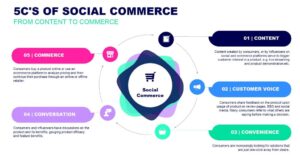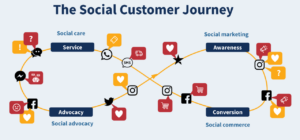Social media platforms have become powerful tools for businesses to connect with their audience and drive sales. With the rise of social commerce, the shift from likes to sales has never been more seamless. Instagram, Facebook, and TikTok have emerged as key players in the realm of social commerce, offering unique opportunities for brands to showcase their products and engage with consumers in a more direct and authentic way. We will look into the strategies and techniques needed to master social commerce on these platforms, helping businesses effectively leverage their social media presence to drive conversions and boost sales.
Understanding the landscape of social commerce

Understanding the landscape of social commerce is crucial in today’s digital age. With the rise of social media platforms such as Instagram, Facebook, and TikTok, businesses have unprecedented opportunities to engage with their audience and drive sales directly through these channels. Social commerce combines the power of social media and e-commerce, allowing users to discover, research, and purchase products seamlessly within their favorite social platforms. Each social media platform offers unique features and tools for businesses to leverage in their social commerce strategies. Instagram, for example, allows businesses to create a visually appealing storefront through Instagram shops and product tags in posts and stories. Facebook offers a robust advertising platform that allows businesses to reach their target audience with precision targeting options. TikTok’s short-form video format is perfect for creating engaging product demos and driving user-generated content to promote products. It’s essential to stay updated on the latest trends and features on each platform to stay ahead in the ever-evolving world of social commerce.
Why social commerce matters
Social commerce streamlines the shopping journey by allowing users to discover, research, and purchase products directly within their favorite social media platforms. This eliminates friction points and fosters impulse buying, making it a win-win situation for both businesses and consumers. Here are some key benefits of social commerce:
- Increased brand awareness: Reach a wider audience through organic reach and targeted social media advertising.
- Enhanced customer engagement: Interact directly with potential customers, answer questions, and build trust.
- Simplified buying journey: Streamline the path to purchase with features like shoppable posts and in-app checkouts.
- Valuable customer insights: Gain valuable data on customer preferences and buying habits through social media analytics.
Leveraging Instagram for social commerce
Instagram is a powerhouse when it comes to social commerce, with its visually appealing platform and engaged user base. To leverage Instagram effectively for social commerce, you need to focus on creating a cohesive and aesthetically pleasing feed that showcases your products in a visually appealing way. Here’s how to maximize your Instagram social commerce strategy:
- High-quality product photography: Showcase your products in a visually stunning and engaging way. Utilize professional photos, lifestyle shots, and user-generated content (UGC) to create a dynamic product experience.
- Shoppable posts: Leverage Instagram Shopping features to tag products directly in your posts. This allows users to seamlessly click and purchase without leaving the app.
- Instagram Stories: Utilize engaging Stories features like polls, quizzes, and questions to spark conversation and product interest.
- Influencer marketing: Partner with relevant influencers to reach a wider audience and leverage their credibility to promote your products.
Harnessing the power of Facebook for social commerce
Harnessing the power of Facebook for social commerce can significantly boost your online sales and brand visibility. With over 2.8 billion monthly active users, Facebook provides a massive platform to reach a vast audience and drive conversions. Here are some effective strategies for Facebook social commerce:
- Facebook Groups: Create dedicated Facebook Groups for your brand to foster a sense of community and exclusivity. Offer product previews, early access deals, and personalized customer support within the group.
- Facebook Live Shopping: Host engaging live shopping events on Facebook to showcase products, answer questions in real-time, and create a dynamic shopping experience.
- Facebook Messenger Chatbots: Implement chatbots to answer customer queries, provide product recommendations, and guide users through the buying process.
- Retargeting Ads: Utilize Facebook’s sophisticated ad targeting capabilities to reach website visitors who haven’t converted and remind them of your products.
Maximizing sales potential on TikTok
Maximizing sales potential on TikTok requires a strategic approach that leverages the platform’s unique features and audience engagement. TikTok is a fast-growing social media platform known for its short-form video content and viral trends, making it an ideal space for businesses to showcase their products and services in creative ways. To maximize sales potential on TikTok, businesses should focus on creating engaging and authentic content that resonates with the platform’s predominantly younger audience. Here are some tips to conquer TikTok social commerce:
- Creative and trendy video content: Leverage trending sounds, challenges, and humor to grab attention and showcase your products in an authentic and entertaining light.
- Partner with TikTok creators: Collaborate with relevant TikTok creators to generate user-authentic content that resonates with your target audience.
- Utilize TikTok challenges: Encourage user participation by creating branded challenges that involve your products.
- TikTok shopping Ads: Utilize TikTok’s in-feed ads that seamlessly link to product landing pages for a smooth purchase experience.
Social commerce is a journey

Building a successful social commerce strategy requires ongoing effort and adaptation. Here are some additional tips to keep in mind:
- Prioritize customer service: Respond promptly to comments and messages, address concerns effectively, and build positive customer relationships.
- Offer exclusive deals and promotions: Incentivize purchases with social media-specific discounts and promotions to drive conversions.
- Track and analyze your results: Monitor key metrics like engagement, reach, and sales to measure the effectiveness of your campaigns and optimize your approach.
- Consistency is also key: Regularly posting content, engaging with your audience, and staying up-to-date with trends can help keep your brand top-of-mind and encourage repeat purchases.
Social commerce secrets: Authenticity, community, and entertainment
Social commerce is more than just pretty pictures and catchy captions. It’s about building genuine connections with your audience. This section unveils the three pillars of success in social commerce: Authenticity, community, and entertainment. We’ll explore how each platform leverages these elements to turn casual scrollers into loyal customers.
Instagram: Authenticity is king
While high-quality product photos are essential, the key to success on Instagram lies in authenticity. Showcase your products in real-life settings, utilize user-generated content (UGC) that features everyday people using your products, and don’t be afraid to show the behind-the-scenes process. This human touch builds trust and connection with your audience, making them more likely to convert from follower to customer.
Facebook: Foster community and personalization
Facebook excels at building communities. The biggest secret here is to foster a space where your audience feels valued and engaged. Create Facebook Groups for your brand that offer exclusive content, early access deals, and personalized customer support. Utilize Facebook Messenger chatbots to provide personalized product recommendations and guide users through the buying journey on a one-on-one basis.
TikTok: Ride the trends and be entertaining
The secret weapon on TikTok is pure entertainment value. People come to TikTok to be amused and discover new things. Don’t just push your products in a salesy way. Instead, create fun and trendy video content that showcases your products in an authentic and entertaining light. Partner with relevant creators, leverage trending sounds and challenges, and inject humor into your videos. When entertainment meets product discovery, magic happens.
Monetization magic: How to monetize your social media presence
Social commerce has exploded in popularity, transforming social media platforms from connection hubs to bustling marketplaces. Learn how to leverage shoppable features, influencer marketing, strategic advertising, and creative content to turn your social media presence into a profitable sales channel. Here’s a breakdown of how to make money on each social commerce platform:
Instagram:
- Shoppable posts & Instagram shopping: This is a core method. Create visually appealing product posts and tag them with shopping tags. This allows users to click directly on the product in the post and seamlessly purchase it within the app.
- Affiliate marketing: Partner with relevant brands and promote their products through affiliate links in your posts and stories. You earn a commission on every sale generated through your unique link. Ensure the products align with your brand and target audience for authenticity.
- Branded content & influencer marketing: Collaborate with brands to create sponsored content featuring their products. Leverage your audience reach and credibility to promote products organically. Negotiate payment methods like a flat fee, commission on sales, or a combination of both.
Facebook:
- Facebook shops: Set up a Facebook Shop as a dedicated storefront within the platform. Here, you can showcase your product catalog, manage inventory, and process payments directly through Facebook.
- Facebook live shopping events: Host interactive live streams to showcase products, answer questions in real-time, and offer exclusive deals. This creates a dynamic shopping experience that can lead to impulse purchases.
- In-App advertising: Utilize Facebook Ads to target specific demographics and interests, reach a wider audience, and drive traffic to your Facebook Shop or website. Promote special offers, new product launches, or retarget website visitors who haven’t converted.
TikTok:
- Branded hashtag challenges: Launch branded hashtag challenges that encourage user-generated content featuring your products. This is a fun and organic way to generate excitement and brand awareness. Offer incentives like prizes or discounts for participation.
- TikTok shopping Ads: Utilize TikTok’s in-feed ads that seamlessly link to product landing pages or your website. These short, engaging video ads can capture attention and drive sales.
- Livestream shopping with In-App purchases: Partner with TikTok to enable live shopping features during your livestreams. This allows viewers to purchase products directly within the live stream without ever leaving the app. (Note: This feature is currently in limited beta testing).
Conclusion.
Social commerce has become an integral part of the modern business landscape, allowing brands to seamlessly merge social media engagement with e-commerce sales. Platforms like Instagram, Facebook, and TikTok offer unique opportunities for businesses to connect with their target audience, showcase products or services, and drive conversions directly within the social media environment. By mastering the art of social commerce on these platforms, businesses can leverage the power of influencer partnerships, shoppable posts, and creative content to drive engagement, build brand awareness, and ultimately increase sales. As social commerce continues to evolve and shape the way consumers interact with brands online, it is essential for businesses to stay up-to-date with the latest trends and best practices to maximize their success in the ever-changing digital landscape.
